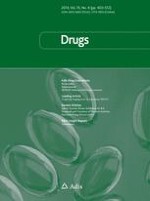01-12-2003 | Leading Article
Phosphodiesterase-4 Inhibitors in the Treatment of Inflammatory Lung Disease
Published in: Drugs | Issue 23/2003
Login to get accessAbstract
Phosphodiesterases (PDE) belong to an important family of proteins that regulate the intracellular levels of cyclic nucleotide second messengers. Targeting PDE with selective inhibitors may offer novel therapeutic strategies in the treatment of various conditions, and in the context of respiratory disease these include asthma and chronic obstructive pulmonary disease (COPD). The rationale for such an approach stems, in part, from the clinical efficacy of theophylline, an orally active drug that is purportedly a nonselective PDE inhibitor. In addition, intracellular cyclic adenosine monophosphate (cAMP) levels regulate the function of many of the cells thought to contribute to the pathogenesis of respiratory diseases such as asthma and COPD, and these cells also selectively express PDE4. This has offered pharmaceutical companies the opportunity to selectively targeting these enzymes for the treatment of these diseases. Finally, the success of targeting PDE5 in the treatment of erectile dysfunction provides clinical proof of concept for the targeting of PDE in disease. Whether a ‘Viagra’ of the airways can be found for the treatment of asthma and COPD remains to be seen, but positive results from recent clinical studies examining the efficacy of selective PDE4 inhibitors such as cilomilast and roflumilast offer some optimism. However, one of the major issues to be resolved is the tolerability profile associated with this drug class that is a consequence of PDE4 inhibition. While cilomilast and roflumilast have low emetic potential they are not free from emesis and various strategies are being investigated in the hope of developing a PDE4 inhibitor without this adverse effect.





